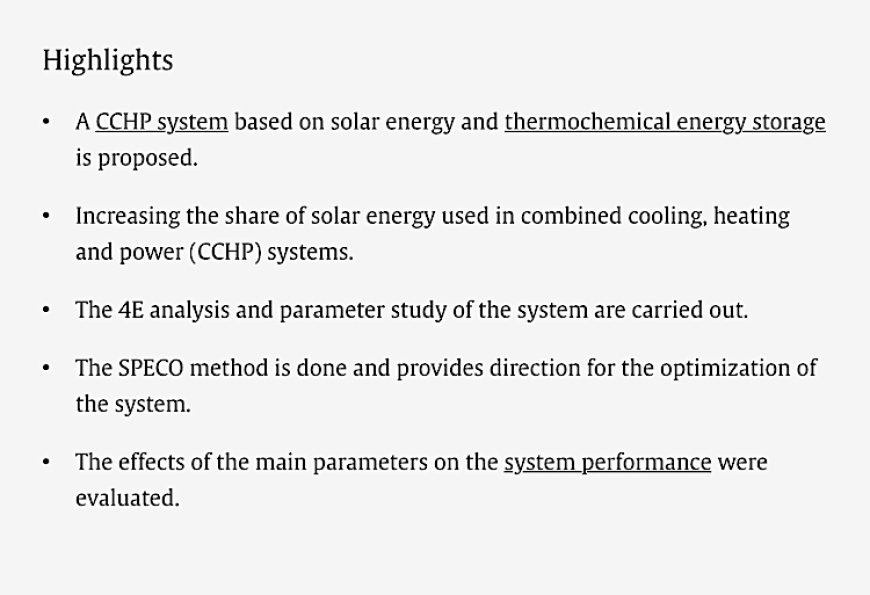Published at Energy Conversion and Management – 4E analysis and parameter study of a solar-thermochemical energy storage CCHP system
Published at Energy Conversion and Management - 4E analysis and parameter study of a solar-thermochemical ... SolarPACES

Abstract:

Abstract:
The combination of calcium looping and concentrating solar power (CSP) is a promising energy conversion technology that can greatly increase the share of solar energy used in combined cooling, heating and power (CCHP) systems. This paper designs a CCHP system based on solar energy and thermochemical energy storage. The system runs all day through day and night modes. Under basic working conditions, the energy and exergy efficiencies of the system could reach 56.92 % and 35.94 %, respectively. The system is evaluated by multiple approaches including parametric sensitivity analysis and 4E (energy, exergy, economy and environment)) analyses. The results demonstrate that the system could produce 2618.09 MW of electricity, 305.56 MW of heat and 523.88 MW of cooling capacity per day, respectively. At the same time, the reductions of CO2 emissions and fossil fuel consumption could reach 2222.76 tons and 696.41 m3 per day, respectively. Furthermore, the increasing mass flow of main turbine inlet could increase both the system efficiency and the exergy efficiency. Thus, it is beneficial to reduce the environmental impact but with the increasing investment cost. In the meanwhile, the exergoeconomic factor and exergoenvironment factor of the system were 55.65 % and 0.139, respectively. Besides, as the extraction flow rate of the intermediate pressure turbine increases, the energy efficiency increases but the exergy efficiency descends. This is unfavorable to reducing the environmental impact, yet it could decrease the investment cost of the system. These results reveal that the hybrid system has the characteristics of high efficiency and emission reduction in energy storage, power generation, heating and cooling, and has great development potential.
Zhang, D., Yang, X., Li, H., Jia, Z., Zhang, S., Tang, S., Liu, D., & Wu, X. (2024). 4E analysis and parameter study of a solar-thermochemical energy storage CCHP system. Energy Conversion and Management, 301, 118002. https://doi.org/10.1016/j.enconman.2023.118002
SDGs, Targets, and Indicators
| SDGs | Targets | Indicators |
|---|---|---|
| SDG 7: Affordable and Clean Energy | 7.2: Increase the share of renewable energy in the global energy mix | The system’s ability to increase the share of solar energy used in combined cooling, heating, and power (CCHP) systems |
| SDG 13: Climate Action | 13.2: Integrate climate change measures into national policies, strategies, and planning | The reductions of CO2 emissions and fossil fuel consumption achieved by the system |
| SDG 9: Industry, Innovation, and Infrastructure | 9.4: Upgrade infrastructure and retrofit industries to make them sustainable | The energy and exergy efficiencies of the system |
1. Which SDGs are addressed or connected to the issues highlighted in the article?
The issues highlighted in the article are connected to SDG 7 (Affordable and Clean Energy), SDG 13 (Climate Action), and SDG 9 (Industry, Innovation, and Infrastructure).
2. What specific targets under those SDGs can be identified based on the article’s content?
The specific targets identified based on the article’s content are:
- Target 7.2: Increase the share of renewable energy in the global energy mix
- Target 13.2: Integrate climate change measures into national policies, strategies, and planning
- Target 9.4: Upgrade infrastructure and retrofit industries to make them sustainable
3. Are there any indicators mentioned or implied in the article that can be used to measure progress towards the identified targets?
Yes, there are indicators mentioned in the article that can be used to measure progress towards the identified targets:
- The system’s ability to increase the share of solar energy used in combined cooling, heating, and power (CCHP) systems can be used to measure progress towards Target 7.2.
- The reductions of CO2 emissions and fossil fuel consumption achieved by the system can be used to measure progress towards Target 13.2.
- The energy and exergy efficiencies of the system can be used to measure progress towards Target 9.4.
4. SDGs, Targets, and Indicators
| SDGs | Targets | Indicators |
|---|---|---|
| SDG 7: Affordable and Clean Energy | 7.2: Increase the share of renewable energy in the global energy mix | The system’s ability to increase the share of solar energy used in combined cooling, heating, and power (CCHP) systems |
| SDG 13: Climate Action | 13.2: Integrate climate change measures into national policies, strategies, and planning | The reductions of CO2 emissions and fossil fuel consumption achieved by the system |
| SDG 9: Industry, Innovation, and Infrastructure | 9.4: Upgrade infrastructure and retrofit industries to make them sustainable | The energy and exergy efficiencies of the system |
Behold! This splendid article springs forth from the wellspring of knowledge, shaped by a wondrous proprietary AI technology that delved into a vast ocean of data, illuminating the path towards the Sustainable Development Goals. Remember that all rights are reserved by SDG Investors LLC, empowering us to champion progress together.
Source: solarpaces.org

Join us, as fellow seekers of change, on a transformative journey at https://sdgtalks.ai/welcome, where you can become a member and actively contribute to shaping a brighter future.







